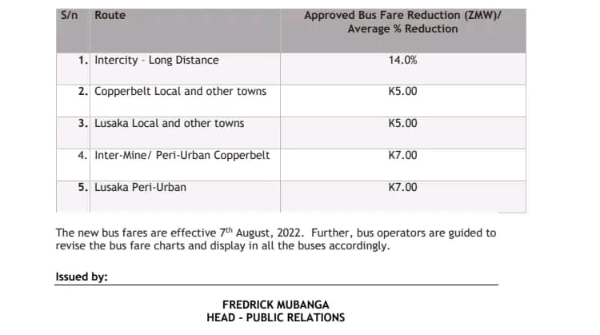By David Chishimba President – Association of Unemployed Youths
We all want prices of goods and services to reduce, so that the cost of living can also reduce, but it shouldn’t be at the expense of others. The economy is interconnected, hurting one sector has ripple effects on other sectors.
I have seen the saga among Taxi and bus drivers and authorities and the general public unfold after the Energy Regulation Board announced the reduction of fuel and diesel by K3.56/litre and K3.14/litre respectively followed by an announcement by Road Transport and Safety Agency’s(RTSA) directing taxi and bus drivers to reduce fares by K7 for intermine and Peri urban areas, K5 for local routes and 14% for intercity bus fares.
This has sparked debates for those who are for the reduction and those who are against. What I have gathered so far is that the Argument for those who are for the reduction is centered around the fact that taxi and bus drivers are quick to increase fares when there is an increase in fuel prices but always drag their feet when the time comes to reduce prices. For those who are against the increase, their argument is that the increment just doesn’t make sense. For example for some routes, when fuel was at K17/litre the fare was at K11,
Now that fuel is at K23, the government wants the fare to be at K9, which economically doesn’t make sense.
Others argue that this should be a lesson and the government should come up with a standard for reviewing fares proportional to petroleum products reviews.
After seeing this deadlock, I took the liberty of reviewing both the increments of fuel and fares starting from February, 2022 because that’s when the the review of the price for petroleum products was changed from 60 days cycle to 30 days cycle. The 60 days cycle has been in place from 2008 until February, 2022. The rationale behind the 60 days cycle was that it took 60 days for petroleum products to be transported via TAZAMA pipelines to reach Zambia and later on filling stations. So the price would remain unchanged for the next 60 days.
The price for petroleum products is determined by the trading of the Kwacha against the dollar and the pump price. The cycle has been changed to 30 days so that consumers can benefit from the gains made by the gain in the country’s currency or the reduction in the pump price which would otherwise not be enjoyed over the 60 days cycle.
That said, let’s look at the increments and reductions of fuel and diesel from February this year and see if we ca make sense of it.
28th February, 2022 – Increment
Petrol – K2.12/litre – From K19.84 – K21.96
Diesel – K2.61/litre – From K18.93 – K21.54
BUS FARES
Intermine – K3
Local routes – K1.5
Intercity – 10%
31st March 2022 – Increment
Petrol – K4.54/litre – From K21.96 – K26.50
Diesel – K4.68/litre – From K21.54 – K26.22
BUS FARES
Intermine – K5
Local routes – K2
Intercity – 15%
30th April, 2022 – Reduction
Petrol – K2.35/litre – From K26.50 – K24.15
Diesel – K0.58/litre – From K26.22 – K25.64
BUS FARES
Intermine – K0
Local routes – K0
Intercity – K10
31st May, 2022 – Increment
Petrol – K0.8/litre – From K24.15 – 24.95
Diesel – K0 – K25.64
BUS FARES
No increments
30th June, 2022 – Increment
Petrol – K1.80/litre – From K24.95 – K26.75
Diesel – K2.37/litre – From K25.64 – K28.01
BUS FARES
Intermine – K3
Local routes – K1.5
Intercity – 10%
31st July, 2022 – Reduction
Petrol – K3.56/litre – From K26.75 – K23.19
Diesel – K3.14/litre – From K28.01 – K24.87
BUS FARES
Proposed Reduction
Intermine – K7
Local routes – K5
Intercity – K14%
MY PROPOSAL
I took the average increment for 3 significant months which are February, March and June for both fuel and diesel.
Average Increments
February – K2.37/litre, March – K4.61/litre, June – K2.09/litre.
The average Increment for the three months gave me K3.02/litre
I also took the average increment for taxi and bus fares for the 3 months which gave me K2.17. I then divided the average increment of petrol and diesel by the average increment of bus fares which gave me K0.72. This means that for every K1/litre increment of fuel and petrol, local routes were increased by approximately K0.72 ngwee.
For example average increment for February, 2022 was K2.37/litre this multiplied by K0.72 gives K1.71. Rounding this off gives K1.5 as bus fare increment for local routes which coincides with the increment in that month.
So for the month of August the bus fare Increment should be:-
K3.35 X K0.72 = K2.41 ~ K2.5 for local routes.
I used the same formular to calculate for intermine and intercity fares. Therefore the taxi and bus fares should be;
Intermine – K4.05
Local routes – K2.5
Intercity – 10%
I know the government is eager to reduce thq cost of living, but it should do it the right way.
Victory is certain.
